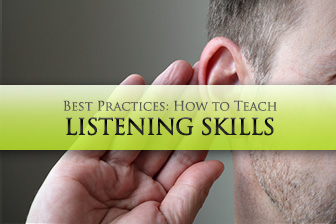How to Teach Listening Skills: Best Practices


If we think listening is a passive activity, we are wrong. And letting our students think listening is a passive activity is even worse. That’s why the best ESL teachers make a point to teach their students to listen actively. Active listening is a learned skill in which the listener pays close attention and feeds back information that they have heard to the speaker. In so doing, the two have better communication and fewer disagreements, especially those based on miscommunication. You can teach your ESL students to be active listeners by going over the following skills essential to the process.

You can’t be a good listener if you don’t know how to be quiet. Pauses in conversation are a natural part of speech, even for first language learners. Help your students understand that they can be quiet and think when they are speaking and that they should also allow their conversation partner silent moments to think before they speak. While you are teaching this, you might also want to teach your students the words and phrases English speakers use as “conversation holders”, cues that they are not finished talking. These include um, like, er, and ah.
Physical clues are very important in a conversation. The best active listeners show their partner that they are listening with a variety of body language. Look at the person. Make eye contact. Nod or show that you understand in other ways. Smile when appropriate. Listeners who do not communicate that they are paying attention might look around the room, look at their watch or their phone, or might not maintain eye contact with the person who is speaking. It is important to point out to your ESL students how different cultural values come into play when it comes to body language and conversation. Give your students a chance to share what is appropriate in their cultures and give them plenty of opportunities to practice correct English speaker body language that might feel uncomfortable for them.
Giving information back to the person you are listening to is a great way to avoid misunderstandings. It also happens to be an active listening strategy. By telling a speaker what you heard or understood, you ensure that you fully get what they are trying to say. This skill is useful for your ESL students because they are sure to have occasions when they do not understand what the other speaker has said due to grammar, vocabulary, or other things. In such cases, your students should repeat the phrase they need clarified to the speaker. What do you mean by X? Can you explain X? What does X mean? Your students can also paraphrase what they think the person has said, that is say the same thing with different words. So when you say X you mean... When your students can use this technique correctly and comfortably, they will no longer have to worry about not knowing certain vocabulary or grammar structures. They can always check with their conversation partner to confirm they are receiving the correct message.
When a person is actively listening, they are trying to understand more than the words that are being said. They are trying to understand how the speaker feels as well. You can help your students by challenging them to ask this question as they listen to an English speaker. What do I think this person feels about this? In some cases it is easy to answer this question. In other cases, the answers don’t come as quickly. But the closer a person listens, the better chance they have of answering that question correctly. Teach your students useful phrases such as, “So it sounds like you feel…about X.” The speaker can then confirm how he really feels about the topic. Trying to understand how a person feels about a topic and then asking for confirmation of your conclusions tells the speaker that you care about what he is saying. It’s important to help your students understand assuming how someone feels might be very dangerous. It is much better to listen to what is being said and then base your conclusion on evidence you see and hear rather than your own instinct or feeling.
Good listeners do more than ask questions when they don’t understand vocabulary or grammar. They also ask probing questions that encourage the speaker to give more information. But there is a right and a wrong way to do this. Help your students understand English discourse by pointing out lulls in the conversation are the best time to ask questions. Wait for the speaker to pause and then ask supportive questions not challenging ones. Point out to your students that open-ended questions are better than yes/no questions. This means that questions starting with who, what, where, when, why, and how are better than those starting with do or did.
It can be tough for anyone to avoid practicing what they will say next in their head while someone else is speaking, and it’s even more of a challenge for your ESL students. Help them understand that paying attention to a speaker is more important than having perfect grammar or pronunciation when they get a chance to speak. Encourage your students to listen fully to their conversation partner and then, when it is their turn to talk, wait three seconds to compose their answer before speaking. When anyone is concentrating more on their answer than what another person is saying, miscommunication is sure to ensue.
It is one that you need, too. The best teachers listen carefully to their students and make their students feel that they understand what is being said. Use these techniques yourself, and you will see that your students feel valued and appreciated no matter what their language level is.